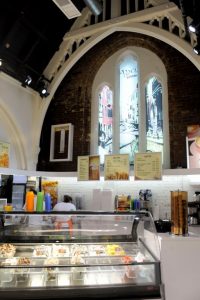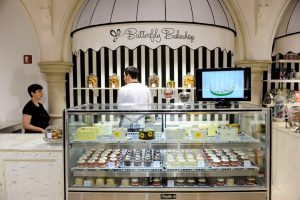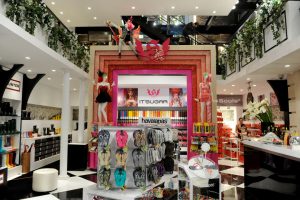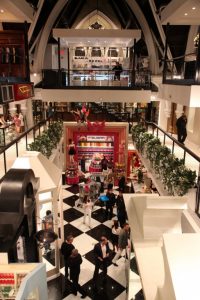First, there’s the calm of the gothic arches and the majesty of the grand rose windows. Only once inside the 170-year-old landmark does the kinetic energy reveal itself in the Limelight Marketplace, the new retail emporium that opened this spring in what was originally the Episcopal Church of the Holy Communion.
Of course, the church subsequently did duty as a community center, drug rehabilitation clinic and the infamous Limelight nightclub, with its history of drug traffic and even a celebrated murder. Now it’s a shopping cathedral on Sixth Avenue and 20th Street, which is appropriate because the area was once New York’s historic Ladies Mile district, the city’s finest retailing neighborhood 100 years ago.
The only exterior adornments are the black and white banners announcing the new retail center, and winged steeple dwellers above. The original wooden front door, contemporized with pearlized white paint, is open as a welcoming gesture.
Inside is a showplace of shape, color and texture. From post modern, Memphis and art deco, to the structure’s original gothic architecture, the space successfully marries seemingly disparate design elements, offering patrons a wide range of experiences. A jewel-like crystal teardrop chandelier hangs in the main vestibule, a product of a shopping trip to The Bowery. Also just inside is a series of small, booth-like boutiques, ranging from Le Sportsac’s contemporary, mirrored façade to Booksmart’s neatly presented collection of children’s books on a series of white library shelves.
Soapology is all vertical stacks of merchandise on weathered wood fixtures against white, porcelain-tiled walls; a Mariebelles Chocolate cart in mid-aisle broadcasts the company’s larger space two levels above.
Moving away from typical mall design, the center features a broad mix of small specialty boutiques, including Carter & Cavero Old World Olive Oil Co., Caswell Massey, Cosme Proud, J. Sisters, Brocade Home and the Butterfly Bakeshop. The journey of discovery includes Havaianas flip flops and Hunter water-tight rubber boots, Mari’s one-bite brownies and Petrossian Caviar, all merchandised in and around the church’s decorative tracery and supportive corbels. There’s even an unassuming Ralph Lauren shop positioned under the eaves.
Designer James Mansour painted an eclectic palette for the center’s overall look, from brocade wall coverings and exposed brick to back-painted glass and distressed woods. The diagonal black and white checkerboard tiles on the main floor mimic the pointed white arches juxtaposed against the peaked black of the ceiling.
Advertisement
Strokes of color abound, especially at the It’Sugar candy shop in what was the apse of the church. The shop’s dramatic art deco façade is constructed entirely of a rainbow of jellybeans, adorned with a grouping of candy-coated mannequins.
Black and white striped walls, dome-shaped awnings, wainscoting and sleek veneers set the stage for a side hall offering of international specialty foods that include foie gras and paté, gourmet chocolates, gelato and oils and vinegars. A complement of wrought iron grille work and weathered wood embellishes Jezalin’s New York Fine Foods, one of the city’s high-end gourmet purveyors.
A black marble stairway leads to the second level mezzanine, which evokes a meandering cobblestone path. The goal of developer Jack Menashe was greater productivity from a smaller footprint with traffic patterns that drive customers through the selling zone. “The three different buildings that initially were the church – and, subsequently, the nightclub – always looked like a rabbit’s warren,” says Mansour. “We had to open walls and make orientation easy, with great circulation and maximum merchandise exposure.”
Speaking of exposure, Mansour started the project with no understanding of the jewel that lay buried under 40 inches of accumulated sheetrock. With no intention of engaging the historic aspects of the building, Mansour began to poke holes through the layers of dry wall to determine the interior dimensions. “A major wow factor was the discovery of the beautiful stained glass under decades of curtain walls and surface treatments,” he says.
His point of view changed and he became an advocate for the history and integrity of the building. The spirit of its structure became a source of inspiration as the removal of refuse revealed the original building core. He even went to London to visit Covent Garden, Dover Street Market and Burlington Arcade, to see what had been done with historic buildings. He also drew upon his early days with Henri Bendel’s celebrated “Street of Shops.” The resurrection of the Limelight became a “festival of shops,” with distinctive architectural frontages and complementary adjacencies.
The Limelight Marketplace brings renewed life to New York’s old Gaslight District with history, intrigue and an unexpected vendor mix. The old church lives again, pulsating with excitement in the form of a new retail cathedral.
PROJECT SUPPLIERS
Limelight Marketplace, New York
Design: Mansour Design, New York
Architect: Todd Zwigard Architects, Aurora, N.Y.
General Contractor: Ikey Tuachi/Extreme Mega Development, Brooklyn, N.Y.
Lighting: GoodMart, New York
Advertisement
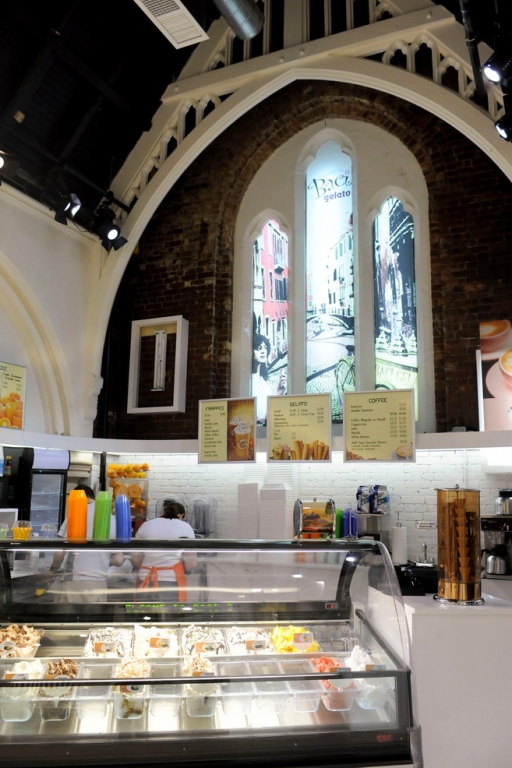

 Photo Gallery2 days ago
Photo Gallery2 days ago
 Headlines1 week ago
Headlines1 week ago
 Headlines2 weeks ago
Headlines2 weeks ago
 Sector Spotlight2 weeks ago
Sector Spotlight2 weeks ago
 Headlines1 week ago
Headlines1 week ago
 Headlines4 days ago
Headlines4 days ago
 Headlines2 weeks ago
Headlines2 weeks ago
 Designer Dozen1 week ago
Designer Dozen1 week ago
